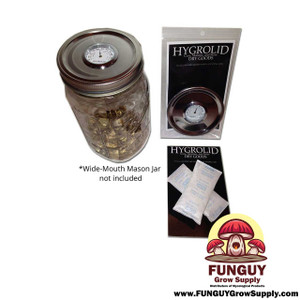Storing Mushrooms, Harvesting & Dehydrating
-

Hygrolid Mushroom Storage System
The Hygrolid Mushroom Storage System If you're a nature enthusiast who values sustainability and looking into mushroom cultivation, you may be interested in learning how to store mushrooms and how to keep mushrooms fresh. The best way to store mushrooms...$16.79
Storing Mushrooms, Harvesting & Dehydrating
You're keen on mushrooms, aren't you? Whether fresh or dehydrated, they're a kitchen staple. But how well do you store them? Improper storage can lead to spoilage and waste. Understanding the science behind proper mushroom storage isn't complicated. Don't worry, we've got all your mushroom storage questions covered.
How to Store Shrooms?
When you're storing mushrooms, it's best to keep 'em whole and unwashed in their original packaging or a brown paper bag in the fridge. Mushroom storage aims to maintain freshness by allowing proper airflow which these methods provide. If you've got locally sourced or self-picked varieties, store mushrooms in a fridge using a bag with the top folded down to absorb moisture.
Remember, when selecting for cooking, go for whole ones with intact caps sans any shriveled patches. Younger ones have compact caps while matured ones flaunt open ones with visible gills. To refrigerate mushrooms effectively and avoid damage, ensure they aren't bruised by other food items in your fridge space.
Mushroom Containers and Storage
You'll find an array of containers and storage options at FunGuy Grow Supply, each designed to keep your fungi fresh and free from contaminants. Our products guarantee the best conditions for storing mushrooms in the fridge or elsewhere, ensuring longevity and freshness.
| Product | Use |
|---|---|
| Silica Gel Drying Canisters | Absorbs water to preserve quality |
| Smart Storage Bags | Ideal for keeping mushrooms fresh |
| Hygrolid Wide Mouth Jar Storage System | Dries, cures, preserves at top flavor & potency |
Whether you need to store mushrooms short-term or want to keep mushrooms fresh longer-term, our diverse range of mushroom containers and storage solutions caters to every need. Trust in our experience and expertise to help maximize your mushroom growing experience.
Dehydrated Mushrooms
After drying, your fungi can last for months and their flavor is even more concentrated. Storing dried mushrooms correctly is essential to keep them fresh and tasty. Keep the dried mushrooms in airtight containers or sealed plastic bags. These should be stored in a cool, dark place like a pantry or cupboard to preserve their quality.
When you're ready to use them, simply rehydrate mushrooms by soaking them in hot water for about 20-30 minutes. After rehydrating, they'll regain their original texture and are ready for cooking. Always inspect your dried mushrooms before use; bad mushrooms may have mold growth or an off smell. With proper storage and care, you can enjoy the rich taste of these earthy gems year-round!
Frequently Asked Questions
Can you freeze mushrooms?
Freezing's another handy method if you're wondering how to preserve a surplus of fresh fungi. Storing fresh mushrooms in this way can help maintain their flavor and texture for future use. Frozen mushrooms are also perfect additions to soups, stews, or casseroles. Freezing mushrooms effectively requires a thorough cleaning but skip wishing - it can make them mushy. Instead, brush off visible dirt and trim the stems. Here's a simple table showing three common storage methods:
| Method | Shelf Life | Flavor preservation |
|---|---|---|
| Storing Mushrooms in Fridge | Up to 1 week | Moderate |
| Freezer | Several months | Texture may be affected |
| Dehydrated (Airtight container) | Up to 1 year or longer | Excellent |
Remember that using storing fresh mushrooms is key; don't try to freezing mushrooms past their prime!
How to Tell If Mushrooms Are Bad?
Determining if your fungi have gone bad can be tricky, but there are several key signs to watch for. Check for sliminess, wrinkles, darkening or dark spots - these indicate mushroom expiration. If they're over two weeks old or emit a strong odor, you've got bad mushrooms. Remember, when in doubt about rotten mushrooms or mushrooms gone bad, it's safer to throw them out.
Do Shrooms Expire?
After learning how to identify bad mushrooms, you might wonder, do shrooms expire? Indeed, they do. Like any perishable food item, they can lose their potency over time or develop harmful bacteria and mold. Proper storage is crucial to prolonging their shelf life. If not stored correctly, even dried shrooms can become expired mushrooms.
Old mushrooms that have lost potency pose a dosing risk since it's challenging to measure the remaining psychoactive compounds accurately. The presence of bacteria or moldy shrooms is another sign of expiration. These could cause stomach upset or respiratory problems in sensitive individuals. Therefore, if your shrooms show these signs, it's safer just to throw them away than risk potential health issues.
How to Dry Mushrooms?
You'll find that drying your favorite fungi can be a simple and rewarding process, giving you the chance to enjoy their flavors all year round. Knowing how to dry mushrooms is not only a practical skill for preserving mushrooms, but it also adds a depth of flavor to your dishes that fresh ones just can't match.
When it comes to storing dehydrated mushrooms:
- You'll savor the intensified, earthy flavors each time you use them in your recipes.
- You'll feel satisfaction knowing you've successfully preserved their quality while saving fridge space.
- You'll enjoy the convenience of having these flavorful additions on hand whenever you need them.
How to Store Mushrooms in the Fridge?
It's crucial to know how to keep your fungi fresh in the fridge, which can be done effectively by using a brown bag lined with paper towels. To store fresh mushrooms, simply place them unwashed on top of the paper towel and then loosely close the medium brown bag. This method is also ideal for keeping mushrooms fresh for four to five days.
If you're wondering how to store shiitake mushrooms or any other variety, this technique works well too. Remember, if your mushrooms go bad, they'll likely develop a slimy texture and off-putting smell. So make sure you check them regularly and use them before their freshness expires! This simple process ensures you have tasty and healthy fungi ready whenever you need them.
How to Store Cut Mushrooms?
When you've sliced your fungi, they'll need a slightly different storage method to remain fresh. Whether you're storing magic mushrooms or just picked up a batch from the mushroom grocery store, it's essential to get the process right.
You can utilize paper grocery bags lined with paper towels for this purpose. If your cut mushrooms came pre-packaged, it's best to leave them in their original container. Either way, always remember:
- Keep them unwashed until use
- Store them in the fridge
- Expect a freshness span of four to five days
Knowing how to store cut mushrooms correctly not only helps retain their quality but also maximizes their lifespan, ensuring you have fresh ingredients whenever needed.
Best Way to Store Mushrooms Long Term?
For long-term preservation, consider options like glass jars, stainless steel containers, or vacuum sealed containers. When figuring out how to store psychedelic mushrooms or shrooms, using airtight glass jars allows you to visually check your stash and prevents the mushrooms from becoming slimy. Stainless steel offers excellent humidity control to maintain quality over time.
If budget permits, vacuum sealed containers are the best way to store mushrooms long term as they keep oxygen at bay that can degrade your shrooms. However, this option might be costlier since it often requires a vacuum sealer. With these methods at hand, you can ensure the longevity and freshness of your mushrooms for extended periods without worrying about degradation or sliminess.
How to Store Dry Mushrooms?
It's crucial to place dry shiitakes in an airtight container and keep them in a cool, dark spot to maintain their quality. When storing mushrooms, especially dehydrated ones, remember:
- Always store dry mushrooms away from light and heat.
- Use a damp paper towel for fresh shiitakes; replace if it gets soggy.
- For prolonged storage, freeze mushrooms or use further dehydration techniques.

